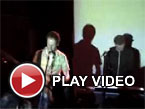Bill Fay, "Still Some Light"
 Bill Fay says David Tibet is probably the only person who would have released this 2CD set. The first disc covers demos and live material from 1970-1971 with Fay’s singing, piano, guitar, bass, and drums combining at times to astonishing effect. The second, lighter disc, recorded at home in 2008, begins with Fay's vocals added to a Michael Cashmore instrumental from The Snow Abides and ends with a song written by his brother, John Fay.
Bill Fay says David Tibet is probably the only person who would have released this 2CD set. The first disc covers demos and live material from 1970-1971 with Fay’s singing, piano, guitar, bass, and drums combining at times to astonishing effect. The second, lighter disc, recorded at home in 2008, begins with Fay's vocals added to a Michael Cashmore instrumental from The Snow Abides and ends with a song written by his brother, John Fay.
Several of Fay’s songs on the Piano, Guitar, Bass & Drums 1970-71 disc were either on his lushly orchestrated debut Bill Fay, or the more stripped down follow up Time of The Last Persecution. The album is made up of tapes found in various locations and approved for release by musicians who obviously had a tight bond. That trust in each other enabled them to keep the music simple. So the sweet, ticking drums, the scattered piano notes, and unfussy bass all make for a perfect unhurried atmosphere in which Fay’s unusual voice flourishes. Additionally, Ray Russell’s wildly brilliant guitar playing adds a barnstorming edge to some of these lovely and deeply personal songs.
At some point Bill Fay must have acquired some conviction that life on Earth would eventually be interrupted by the intervention of a higher spiritual power; an intervention prophesied to fix the folly and misguided actions of humans that had wrought widespread war, false idols and misery. His images interpret the book of Revelation yet he conveys a gentle vulnerability and humanity which make apocalypse and salvation all sound rather comforting. That he also sings of not kneeling in "dead cathedrals" and complains of a spire "that blocks out the sky" is rather appealing. The versions of “Plan D” and “Pictures of Adolph Again” are love songs to the joy of existence albeit with a backdrop of horror and delusion. I hate to compare Fay to anyone else, but the warmth generated by his voice and Russell’s guitar on “I Hear You Calling” put me in mind of the late Ronnie Lane at his most soulful. Fay’s genuinely touching love of nature, his appreciation of his landscape of origin, and his love for his family both balances and compliments his other concerns. His honesty is unmistakable since he obviously sings about his own back yard. I also can’t think of another songwriter who mentions trees quite as often and treats the minutiae of everyday life—door keys, dustbins, your team losing, old school friends who have passed away—with such a matter-of-fact reverence.
I have never heard anyone sing or tell stories quite like Bill Fay. His phrasing and dialect are, if not unique, then certainly unusual, and his lyrics are disarmingly direct. It’s as if a character from Adam Thorpe’s odd rural epic Ulverton has come to life and is regaling us with history, observations of nature, and heavy portent. There is a consistently humble quality to Fay’s voice and yet it manages to be mesmerizing. I say humble, but when he speaks the words to “I Will Find My Own Way Home” he seems to be acknowledging failings (perhaps a crisis of faith) but sounds as determined and cocksure as if he were auditioning for the role of Brian Clough in The Damned United.
The second disc, Still Some Light, is lighter and several of the tracks seem a bit over-sentimental at first. Maybe they are, but what emerges is Fay’s loyalty to his natural mode of expression. For example, “Hello Old Tree” is enveloped in the feeling of returning again and again for reverie to a favorite spot in his landscape. That song makes me think of John Cooper Powys’ notion that all of creation, including trees and stones, has a soul. Equally, the song “Diamond Studied Days” revels unashamedly in a strong feeling of grateful nostalgia that mirrors its topic: the love Fay’s parents gave him as a child. He merges several of his main themes, nature, peace and spiritual redemption, on the hymn-like track "There Is A Valley". His singing (of his own words) on “My Eyes Open” defies the truth that they were written quite separately for Michael Cashmore's originally unrelated music, so good is the match. Like most of the second disc, the piece is quiet and lush. By contrast, “I Wonder,” the final track written by John Fay, has a pleasantly rough production and a ragged acoustic edge that some might associate with Syd Barrett.
Fay's brother did the cover and booklet paintings and there are some completely natural looking photographs of Bill Fay and his close family in which he seems happy and contented and his hair looks like it hasn't been combed maybe since his mother tried to do it when he was a schoolboy! In the booklet he writes one of the longest thank you letters I've ever read. With almost forty years betwen these recordings the over-riding feeling is that there's no pretense and, depite some of the grand concerns, no preaching. I find some of the songs less successful than others but mainly enjoy the lovely imperfections of these marvelous demos and home recordings. This is the sound of someone recognizing danger and fears, but hoping and trusting for the best. Bill Fay’s proceeds from this album will go to “the major charities active in the poorest places of the world.” Including, I believe, Doctors Without Borders/Médecins Sans Frontières.
samples disc 1:
samples disc 2:



